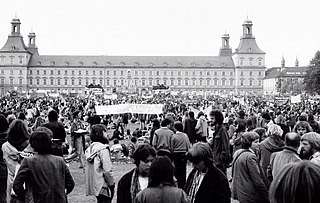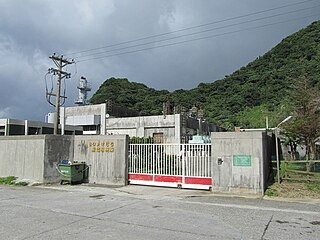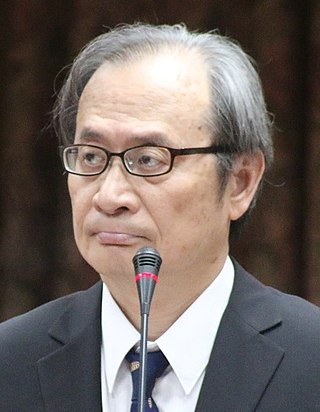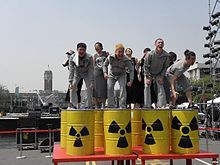
Orchid Island, also known by other names, is a 45 km2 (17 sq mi) volcanic island off the southeastern coast of Taiwan, which Orchid Island is part of. It is separated from the Batanes of the Philippines by the Bashi Channel of the Luzon Strait. The island and the nearby Lesser Orchid Island are governed as Lanyu Township in Taitung County, which is one of the county's two insular townships.

A nuclear power phase-out is the discontinuation of usage of nuclear power for energy production. Often initiated because of concerns about nuclear power, phase-outs usually include shutting down nuclear power plants and looking towards fossil fuels and renewable energy. Three nuclear accidents have influenced the discontinuation of nuclear power: the 1979 Three Mile Island partial nuclear meltdown in the United States, the 1986 Chernobyl disaster in the USSR, and the 2011 Fukushima nuclear disaster in Japan.

The anti-nuclear movement is a social movement that opposes various nuclear technologies. Some direct action groups, environmental movements, and professional organisations have identified themselves with the movement at the local, national, or international level. Major anti-nuclear groups include Campaign for Nuclear Disarmament, Friends of the Earth, Greenpeace, International Physicians for the Prevention of Nuclear War, Peace Action, Seneca Women's Encampment for a Future of Peace and Justice and the Nuclear Information and Resource Service. The initial objective of the movement was nuclear disarmament, though since the late 1960s opposition has included the use of nuclear power. Many anti-nuclear groups oppose both nuclear power and nuclear weapons. The formation of green parties in the 1970s and 1980s was often a direct result of anti-nuclear politics.

The Lungmen Nuclear Power Plant, formerly known as Gongliao and commonly as the Fourth Nuclear Power Plant, is an unfinished nuclear power plant in New Taipei City, Taiwan. It consists of two ABWRs each of 1,300 MWe net. It is owned by Taiwan Power Company (Taipower).
The Taiwan Power Company, also known by the short name Taipower, is a state-owned electric power industry providing electricity to Taiwan and its off-shore islands.
In 2008, nuclear energy provided Switzerland with 40 percent of its electricity, but a survey of Swiss people found that only seven percent of respondents were totally in favor of energy production by nuclear power stations. Many large anti-nuclear demonstrations and protests have occurred over the years.

Anti-nuclear protests began on a small scale in the U.S. as early as 1946 in response to Operation Crossroads. Large scale anti-nuclear protests first emerged in the mid-1950s in Japan in the wake of the March 1954 Lucky Dragon Incident. August 1955 saw the first meeting of the World Conference against Atomic and Hydrogen Bombs, which had around 3,000 participants from Japan and other nations. Protests began in Britain in the late 1950s and early 1960s. In the United Kingdom, the first Aldermaston March, organised by the Campaign for Nuclear Disarmament, took place in 1958. In 1961, at the height of the Cold War, about 50,000 women brought together by Women Strike for Peace marched in 60 cities in the United States to demonstrate against nuclear weapons. In 1964, Peace Marches in several Australian capital cities featured "Ban the Bomb" placards.

High-level radioactive waste management addresses the handling of radioactive materials generated from nuclear power production and nuclear weapons manufacture. Radioactive waste contains both short-lived and long-lived radionuclides, as well as non-radioactive nuclides. In 2002, the United States stored approximately 47,000 tonnes of high-level radioactive waste.
National nuclear energy policy is a national policy concerning some or all aspects of nuclear energy, such as mining for nuclear fuel, extraction and processing of nuclear fuel from the ore, generating electricity by nuclear power, enriching and storing spent nuclear fuel and nuclear fuel reprocessing. Nuclear energy policies often include the regulation of energy use and standards relating to the nuclear fuel cycle.

The nuclear energy policy of the United States began in 1954 and continued with the ongoing building of nuclear power plants, the enactment of numerous pieces of legislation such as the Energy Reorganization Act of 1974, and the implementation of countless policies which have guided the Nuclear Regulatory Commission and the Department of Energy in the regulation and growth of nuclear energy companies. This includes, but is not limited to, regulations of nuclear facilities, waste storage, decommissioning of weapons-grade materials, uranium mining, and funding for nuclear companies, along with an increase in power plant building. Both legislation and bureaucratic regulations of nuclear energy in the United States have been shaped by scientific research, private industries' wishes, and public opinion, which has shifted over time and as a result of different nuclear disasters.
The following outline is provided as an overview of and topical guide to nuclear power:

The Kuosheng Nuclear Power Plant or Guosheng Nuclear Power Plant, Second Nuclear Power Plant, was a nuclear power plant in Wanli District, New Taipei, Taiwan. The plant was the largest nuclear power plant in Taiwan.

The Jinshan Nuclear Power Plant or Chin Shan Nuclear Power Plant (金山核能發電廠), First Nuclear Power Plant, is a nuclear power plant being decommissioned in Shimen District, New Taipei, Taiwan. Commissioned in 1978, the plant was Taiwan's first and smallest nuclear power plant.

The Low-Level Radioactive Waste Storage Site, formerly Lanyu Storage Site, is a facility to store all of the nuclear waste produced by three nuclear power plants in the Republic of China in Lanyu Island, Taitung County. It is owned and operated by Taipower.

The electricity sector in Taiwan ranges from generation, transmission, distribution and sales of electricity, covering Taiwan island and its offshore islands.

Renewable energy in Taiwan contributed to 8.7% of national electricity generation as of end of 2013. The total installed capacity of renewable energy in Taiwan by the end of 2013 was 3.76 GW.

The Lanyu Power Plant is a fuel-fired power plant in Yuren Village, Orchid Island, Taitung County, Taiwan. It is the only power plant on Orchid Island.

Hsieh Shou-shing is a Taiwanese politician who served as minister of the Atomic Energy Council from 20 May 2016 to his removal from office on 11 January 2023.

Mary Chen or Chen Man-li is a Taiwanese environmentalist and politician. A longtime leader of the Homemakers' Union and Foundation and the National Union of Taiwan Women’s Associations, she was an active member of Green Party Taiwan before joining the Democratic Progressive Party in 2015. She represented the DPP in the 2016 legislative elections, and won a seat via party list proportional representation.


























